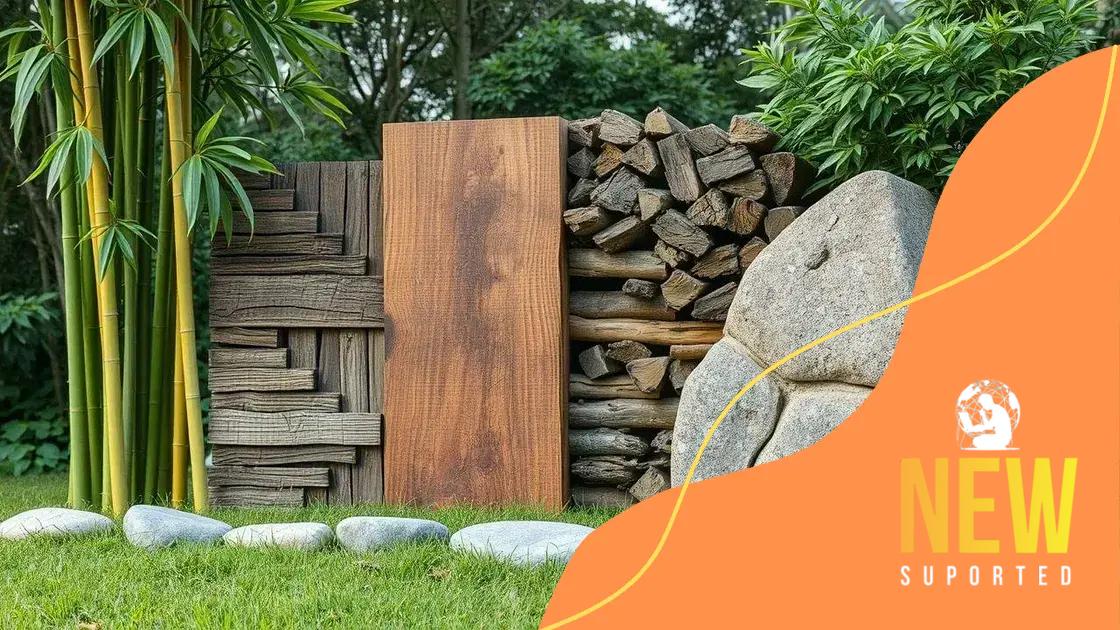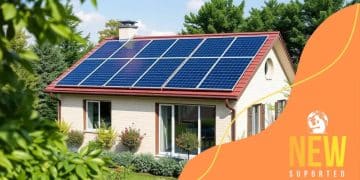Sustainable building materials for eco-friendly homes

Sustainable building materials are eco-friendly resources like bamboo, recycled steel, and reclaimed wood that minimize environmental impact, enhance energy efficiency, and improve indoor air quality.
Sustainable building materials for eco-friendly homes are becoming increasingly essential for homeowners seeking to reduce their environmental impact. Have you ever wondered how these materials can transform your living space and contribute to a healthier planet?
Understanding sustainable building materials
When it comes to building eco-friendly homes, understanding sustainable building materials is crucial. These materials not only benefit the environment but also enhance the livability of spaces.
One of the most significant advantages of using sustainable materials is their ability to reduce a home’s carbon footprint. Buildings constructed with sustainable materials often lead to lower energy consumption and improved indoor air quality.
Types of Sustainable Building Materials
There are several categories of sustainable materials that you can choose from:
- Bamboo: A fast-growing grass that is incredibly strong and versatile.
- Recycled materials: Items like reclaimed wood and recycled metal help reduce waste.
- Straw bales: An excellent insulator and renewable resource.
- Hempcrete: A sustainable alternative to conventional concrete made from hemp fibers.
Choosing the right materials is not just about environmental impact. Many of these products are also economical. For example, using bamboo can lead to cost savings in structural components due to its strength and low weight.
Moreover, sustainable materials often have a much lower cost of maintenance over time. Using products like recycled rainwater systems or green roofs can dramatically lower utility bills.
Benefits of Understanding Sustainable Materials
Understanding the intricacies of these materials can empower homeowners and builders to make informed decisions. With an increasing focus on sustainability, the market for these materials is expanding, offering more options than ever.
Additionally, using sustainable building materials can significantly contribute to the health and comfort of your home. Better air quality and insulation can lead to a better overall living experience.
In summary, being knowledgeable about sustainable building materials not only promotes eco-friendliness but also enhances economic and health benefits. The choices made today will impact the future of our homes and the environment.
Top eco-friendly materials for construction
When building an eco-friendly home, knowing the top eco-friendly materials for construction can make a significant difference. These materials not only help the environment but also can enhance the aesthetic appeal and durability of your home.
Using recycled steel for framing can be a smart choice. This material is strong, lightweight, and helps reduce waste by reusing metal that would otherwise be discarded. With its resistance to rust and pests, it provides a long-lasting solution.
Bamboo
Bamboo is another excellent material that grows rapidly and can regenerate quickly without the need for replanting. This grass is incredibly durable and can be used for anything from flooring to structural beams.
Reclaimed Wood
Reclaimed wood is not only beautiful but also reduces the demand for newly harvested timber. Each piece has its own story, adding character to homes while minimizing deforestation.
Natural Insulation
Natural insulation materials, such as sheep’s wool and cellulose, are eco-friendly choices that provide excellent thermal performance. They regulate humidity and help keep homes comfortable year-round.
- Straw Bales: Provide great insulation and are biodegradable.
- Hempcrete: A sustainable alternative to concrete that is breathable and lightweight.
- Recycled Glass: Can be used in countertops and tiles, reducing landfill waste.
Moreover, using green roofing systems not only provides insulation but also helps to filter rainwater and support local biodiversity. These systems can transform a conventional roof into a thriving habitat.
Another innovative option is using rammed earth, which creates sturdy and energy-efficient walls by compacting soil. This material is abundant and can be a beautiful, natural addition to your home.
Benefits of using sustainable materials

The benefits of using sustainable materials are numerous and can greatly enhance your building project. Not only do these materials help the environment, but they also improve the quality of life for the inhabitants.
One of the most significant benefits is the reduction of the carbon footprint. By choosing materials that are sustainably sourced, you help lessen the impact on the environment. This means cleaner air and a healthier planet for future generations.
Improved Indoor Air Quality
Using sustainable materials often leads to better indoor air quality. Many conventional materials release harmful chemicals into the air, leading to health issues. In contrast, natural materials like bamboo and reclaimed wood do not contain toxic substances.
Cost Savings
Another advantage is cost savings over time. While sustainable materials may have a higher initial cost, they offer durability and lower maintenance costs. For example, using recycled steel in construction provides strength without frequent repairs.
Energy Efficiency
Many sustainable materials contribute to higher energy efficiency. Insulation made from natural products keeps homes warm in winter and cool in summer, reducing the need for heating and cooling. This not only saves money but also reduces energy consumption.
- Longevity: Sustainable materials often have longer lifespans, meaning less frequent replacements.
- Resilience: They tend to withstand weather conditions better than conventional materials.
- Community Support: Choosing local materials supports local economies and reduces transportation emissions.
Beyond these practical benefits, using sustainable materials can enhance the aesthetic appeal of a home. Natural textures and colors create warm and inviting spaces that resonate with nature. Ultimately, embracing sustainable building practices contributes to a more sustainable and connected community.
How to choose the right materials
Choosing the right materials for your eco-friendly home is essential in achieving sustainability. Knowing how to select sustainable building materials can help you make informed choices that benefit both the environment and your living space.
First, consider the source of the materials. Are they locally sourced? This can significantly reduce transportation emissions and support local economies. Opting for materials that are plentiful in your area often translates to lower costs and reduced environmental impact.
Evaluate Material Properties
Next, assess the properties of each material. Durability, maintenance requirements, and insulation capabilities are crucial factors. For example, bamboo is not only strong but also grows quickly, making it a renewable option. Insulation made from recycled materials can offer excellent thermal performance.
Check for Certifications
Look for certifications that confirm a material’s sustainability. Certifications such as FSC (Forest Stewardship Council) for wood, or LEED (Leadership in Energy and Environmental Design) ratings can guide you in making eco-friendly choices. These certifications ensure that the products meet strict environmental standards.
Consider Lifecycle Impacts
Think about the entire lifecycle of the materials. Examine their environmental impact from extraction to disposal. Materials that can be recycled or have low emissions during production are more sustainable choices. This long-term perspective helps in minimizing waste and conserving resources.
- Research Options: Conduct thorough research to find materials with the best ecological benefits.
- Prioritize Quality: Invest in high-quality materials that last longer and reduce the need for replacements.
- Seek Expert Advice: Consulting with sustainable building professionals can provide helpful insights.
Involving your community in the selection process can also yield unique materials that reflect local culture. Choosing the right materials not only contributes to sustainability but also creates a distinctive and personal touch in your home.
Innovative trends in sustainable architecture
Innovative trends in sustainable architecture are shaping the future of building design and construction. These trends focus on minimizing environmental impact while maximizing efficiency and aesthetic appeal. As more architects and builders embrace eco-friendly practices, exciting ideas are emerging.
One of the most prominent trends is the integration of green roofs and living walls. These features not only provide insulation but also support biodiversity by creating habitats for various species. They help in rainwater management and improve air quality, making urban environments greener.
Smart Building Technologies
Another significant trend is the incorporation of smart building technologies. These systems use advanced sensors to monitor energy use and optimize efficiencies. For example, automated lighting and heating systems adjust based on occupancy and weather patterns, reducing unnecessary energy consumption.
Modular and Prefabricated Construction
The rise of modular and prefabricated construction is transforming how buildings are created. These methods allow for improved quality control and faster construction times while minimizing waste. By assembling buildings in controlled environments, less material is wasted.
Use of Recycled and Eco-Friendly Materials
Architects are increasingly using recycled materials, such as reclaimed wood and repurposed metal, in their designs. This trend not only reduces landfill waste but also gives new life to materials that have a story and character.
- Passive Solar Design: Maximizes natural light and warmth from the sun to heat and illuminate spaces.
- Water Efficiency: Innovations in plumbing and irrigation reduce water consumption and promote conservation.
- Biophilic Design: Incorporates nature into the built environment to enhance mental well-being.
As these innovative trends in sustainable architecture continue to develop, they are paving the way for a more sustainable and harmonious relationship between buildings and their environments. Embracing these advancements not only benefits the planet but also enhances the quality of life for those who inhabit these spaces.
FAQ – Frequently Asked Questions About Sustainable Building Materials
What are sustainable building materials?
Sustainable building materials are resources that are environmentally friendly, renewable, and have minimal impact on the ecosystem. They are sourced and produced in ways that conserve natural resources.
How do sustainable materials benefit the environment?
Using sustainable materials helps reduce carbon footprints, minimize waste, and lower energy consumption, contributing to a healthier planet and improved air quality.
Can sustainable materials save me money?
Yes, while some sustainable materials may have higher initial costs, they typically lead to lower energy bills and reduced maintenance costs over time.
What are some examples of innovative trends in sustainable architecture?
Innovative trends include green roofs, smart building technologies, modular construction, and the use of recycled materials, all aimed at enhancing sustainability in architecture.






